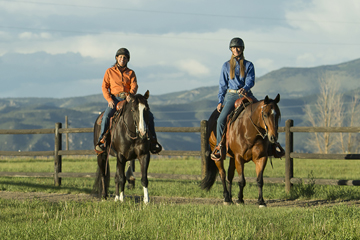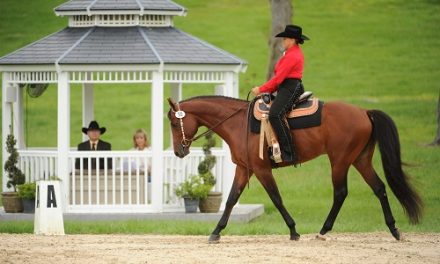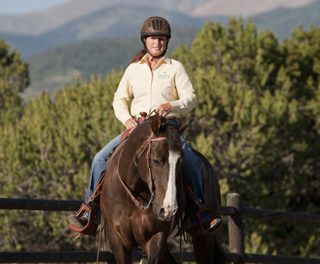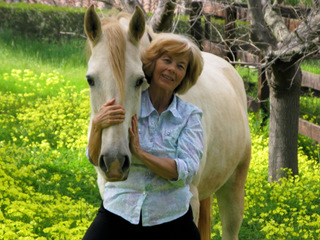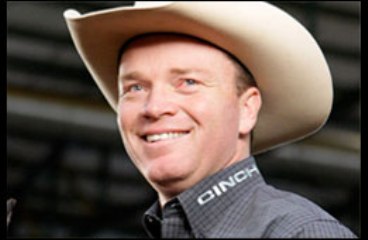Ask Julie Goodnight
 Question:
Question:
Dear Julie, I’ve seen your show on RFD-TV about how to lower your horse’s head. In the episode you mentioned something about spurs, how to use the spurs at the right time and it’s not always a good idea to use on a lazy horse. My question is when I get ready to ride my horse, how do I make it go forward? Do I need spurs? I kick and pull but it won’t move forward. Does my horse need more training? I need advice. –Bryant
Answer:
Hi Bryant,
Thanks for watching the show. We get lots of feedback from people on how much they learn in each episode and often they say they watch the show again and again and pick up something new each time. The truth is, there is a lot of info packed into a half-hour show and there are always things I wish I had more time to address. You touch on several really good issues in your question and I need to make a clarification about when to use spurs and when not to.
When talking about getting your horse to lower his head and round his frame, I always talk about using a lot of leg (not spur) and that you always increase leg pressure when you increase rein pressure. There are many articles in my Training Library that address the horse’s frame, lowering the head and collection and volume 5 in my riding DVD series, Refinement and Collection gives extensive instruction as well.
Before you ask for any horse to lower his head and round his frame, he must be moving freely and willingly forward in all gaits. This is a much more basic and fundamental stage of training which far precedes collection and rounding of the frame. Forward motion is one of the most fundamental tenets of classical horsemanship. Anyone who has ever started colts knows this—you cannot teach them anything (stop, go, turn) until they are moving freely forward. Free and forward movement is the basis of all training.
If your horse is not moving freely forward on command in all gaits, you must address this fundamental problem before you can ask a horse to lower its head or anything else. As with all training problems, you must first and foremost consider a physical cause. You’d be surprised how often people pour thousands of dollars and hours into training when the horse was acting that way because he was in pain—an ill-fitting saddle, a painful bit, a sore joint, a rib out of place that only hurts when you ask him to canter (right before he bucks you off). With a horse that is not moving willingly forward, it could be any of these and dozens of other physical causes. Best to have your horse assessed by a vet to rule out any issues.
Once a physical problem is ruled out as a possible cause of the horse’s refusal to move forward, then you can look to the horse’s training. First off, does he have any clue of what you are asking him to do? You’d be surprised how many horses are being ridden regularly but have very little actual training. When it comes to responding to the bit and cues, it has to be taught by someone. Often I see horses that just simply are untrained even though they are packing a rider down the trail with no problems. A horse must be taught how to respond to rein pressure; it does not come naturally to a horse. If your horse is lacking basic training, watch my video on Bit Basics and you can easily learn to train your horse for a light response and low head carriage.
The next thing to consider, is learned behavior by your horse? In other words, does the horse know better (to move off your leg) but is acting this way now because it has worked so well for him in the past? It doesn’t take much of a perceived gain for a horse to learn that his refusal gets him what he wants—many insensitive horses will gladly endure the kicking and spurring from a rider if it means he doesn’t have to lope circles or do any work. Again, there are articles in my training library that may help if this is the case.
However, as is often the case, and the topic of an episode of Horse Master we just taped (it will air in May ‘11), in some cases the problem is that the rider is giving the horse conflicting signals by pulling back on the reins when she wants the horse to go forward. If you are riding a lazy horse or one that is reluctant to move forward in some situations (like when approaching a giant mud puddle—as in the case of the episode we just taped), and you pull back on the reins, the horse will choose to take that as permission to stop. Any backward pull on the reins inhibits forward motion; that is a fundamental truth that you should always remember. In some cases, we do want to inhibit forward motion, like when asking the horse to stop or collect his frame (but he has to be moving freely forward first). But in many cases, riders are pulling on the reins, inhibiting forward motion when they don’t really mean to, like when the horse spooks, balks, backs or is just plain being lazy.
Remember that forward motion precedes all other training concerns and when you need the horse to move more forward, you must reach forward with your hands towards the horse’s ears. If you pull back on the reins when the horse is not moving freely forward or even just keep your hands in a neutral position, the horse is unlikely to move forward. Actively pulling back on the reins of a lazy horse or one that is not moving forward for any other reason will always make the problem worse.
As to your question about spurs, let me clarify what I said on the show and how I feel about this artificial aid. I said that, to me, the use of spurs is not a good choice on a lazy horse. It is not an aid to make a slow horse faster; it is an advanced-level aid for advanced riders to use on advanced horses to motivate them to a higher level of performance and do more difficult maneuvers. If the problem with your horse not moving forward is simply because he is lazy and has learned to ignore a polite request from your legs, then he needs to be reminded to respond to a light leg.
I prefer the use of the crop to reinforce your leg aid, rather than the spur, in the instance of the horse not moving forward off a light leg cue. A spur will often make the lazy horse even duller to your leg and make him sull up and balk even more. Kicking harder on a lazy horse also does not work well because the lazy horse will tolerate the pressure and just wait for you to quit kicking from exhaustion (which doesn’t take long).
To use the crop as a reinforcement to your light leg aid, in a horse that is trained but not responding, ask once lightly for forward movement with a shift of your weight forward and a gentle bump with your calves (and a dramatic forward reach with your hands). If he ignores your polite initial request, immediately reinforce your leg cue with a sharp spank with the crop right where your leg cued him (make sure you keep reaching forward with your hands—a lot!). If done right, this will undoubtedly send him expeditiously forward, but do not contradict yourself as most riders do by then pulling back on the reins (and punishing him for doing what you asked him to do). Let him move forward freely and only stop him when he is voluntarily moving forward, without any pedaling from you.
Then ask your horse again lightly to move off your legs, prepared to reinforce with the crop again if needed, but always giving him the opportunity to respond to your light aids first. If your timing was good the first time and you used adequate pressure to motivate the horse, the second time you ask with your legs, he should step right off. But you may need more than one spanking before the horse begins to take your leg cues seriously again. With good timing and the right skill level of the rider, the horse will be moving freely forward in minutes. Again, this is a tip for refreshing a trained horse that has become unresponsive– you would train a young horse that didn’t know better a little differently.
I did a “Quick Tip” for Horse Master recently, which may be airing soon, about the use of spurs. Basically it said that spurs are neither a piece of apparel nor a fashion statement, they are an artificial aid. And like many artificial aids, they have a propensity to be used incorrectly, even abusively and they can become a crutch to good riding. I believe that spurs should only be used by an advanced rider that has excellent control over their balance and leg position; inadvertent/indescriminant use of the spur will confuse a horse and can be downright dangerous on some horses. I also believe that with an advanced rider, training a horse to do advanced maneuvers (like collection, lateral movements or other maneuvers that require more effort from the horse), the spur can be a useful tool to motivate the horse to try a little harder. I have written a lot about “finding the amount of pressure that motivates change,” so I’ll let you read up more on this concept by visiting my Training Library (http://juliegoodnight.com).
I think that covers your questions and answers to a few you didn’t ask too! Thanks for watching Horse Master and keep learning!
Enjoy the ride,
–Julie Goodnight Trainer and Clinician

